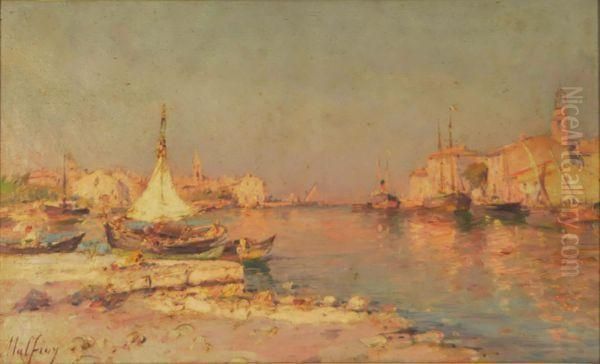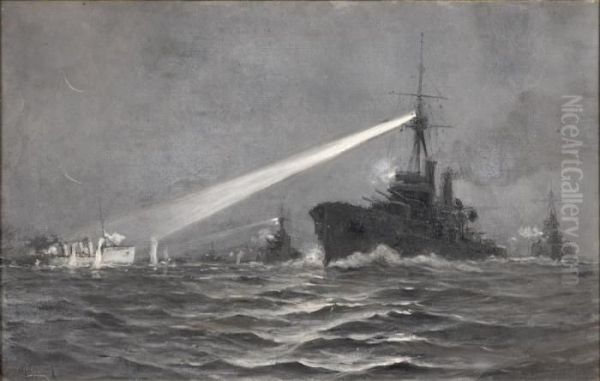Charles Malfroy stands as a significant figure in French Post-Impressionist landscape painting, celebrated primarily for his evocative depictions of Mediterranean harbours and coastlines. Born in the latter half of the 19th century, his work bridges the innovations of Impressionism with a more structured, yet deeply atmospheric, approach to capturing the unique light and character of the South of France. His paintings, particularly those of the bustling yet serene port of Martigues, continue to resonate with collectors and art lovers for their vibrant colour, sensitivity to light, and tranquil beauty.
Understanding Charles Malfroy requires navigating a degree of historical confusion, as his name is sometimes conflated with his son, Henri Malfroy, also a painter of similar subjects, and perhaps more significantly, with the sculptor Charles Malfray. This article focuses specifically on Charles Malfroy (1862-1939), the landscape painter, distinguishing his life and work from these other figures while placing him within the rich artistic context of his time.
Early Life and Artistic Formation
Charles Malfroy was born on May 27, 1862, in Lyon, France. Lyon, a city with its own rich artistic heritage, provided the initial backdrop for his development. He pursued formal art training at the École des Beaux-Arts in Lyon, an institution that would have grounded him in academic principles of drawing and composition. This foundational training provided the technical bedrock upon which he would later build his more personal, light-filled style.
Following his studies, Malfroy began his professional career, likely exhibiting his work initially in Lyon before seeking broader recognition. Like many ambitious artists of his generation, he was drawn to Paris, the undisputed centre of the art world. Participation in the major Parisian Salons was crucial for establishing a reputation, and Malfroy would become a regular exhibitor.
His early work likely reflected the prevailing academic or Barbizon-influenced styles taught at the Beaux-Arts. However, the artistic ferment of the late 19th century, particularly the lingering impact of Impressionism and the rise of various Post-Impressionist tendencies, would profoundly shape his mature artistic vision. He absorbed the lessons of capturing fleeting light and atmospheric effects but adapted them to his own temperament and subject matter.
The Development of a Post-Impressionist Style

Malfroy's artistic journey led him firmly into the realm of Post-Impressionism. While he embraced the Impressionists' emphasis on light and colour, and their practice of painting outdoors (en plein air) to capture immediate sensations, his work often displays a greater sense of structure and solidity than that of painters like Claude Monet or Alfred Sisley. He was less concerned with dissolving form entirely in light and more interested in rendering the tangible reality of places, imbued with specific atmospheric conditions.
His palette became characteristic: rich blues and greens for the water, warm ochres, pinks, and oranges for buildings and sails, often set against the luminous sky of the Mediterranean. He demonstrated a keen sensitivity to the way light reflects off water, creating shimmering, broken patterns of colour. His brushwork, while often visible and energetic, was typically used to build form and texture, rather than solely to capture a momentary impression.
A defining feature of Malfroy's style is his ability to evoke mood and atmosphere. His harbour scenes are rarely just topographical records; they convey the tranquility of early morning, the heat of midday, or the calm of evening. This focus on atmosphere, combined with a vibrant but controlled use of colour, places him alongside contemporaries who sought to move beyond Impressionism towards more personal or structured forms of expression, a broad movement that also included artists like Paul Cézanne and Paul Signac, though Malfroy pursued his own distinct path.
The Mediterranean Muse: Martigues and Beyond
The subject matter most intrinsically linked to Charles Malfroy is the Mediterranean coast, particularly the harbours of Provence. He found endless inspiration in the interplay of water, boats, architecture, and the unique southern light. Among his favoured locations, the port of Martigues stands out. Situated near Marseille, Martigues, often nicknamed the "Venice of Provence" due to its canals, provided Malfroy with a perfect combination of picturesque elements.
His paintings of Martigues capture the colourful fishing boats (known as "pointus"), the reflections of buildings in the calm canal waters, and the daily life of the port. He painted the town from various viewpoints and at different times of day, exploring the changing effects of light on the scene. Works titled Port de Martigues, Canal à Martigues, or Les Martigues appear frequently in his oeuvre, showcasing his sustained engagement with this location. These paintings are celebrated for their harmonious compositions and luminous quality.

While Martigues was a primary focus, Malfroy also depicted other locations along the French Riviera (Côte d'Azur) and possibly ventured further afield to capture scenes in Italy or North Africa, although documentation for this is less extensive. His commitment remained consistent: to render the specific character and light of these sun-drenched coastal environments. He shared this fascination with the Mediterranean with other artists, such as Jean-Baptiste Olive, who also specialized in Provençal landscapes and seascapes, and Félix Ziem, famous for his shimmering views of Venice and Constantinople.
Parisian Scenes and Other Subjects
Although best known for his Mediterranean views, Charles Malfroy did not limit himself exclusively to the coast. He also produced paintings of Paris, capturing the elegance and dynamism of the French capital. Works depicting landmarks like the Arc de Triomphe demonstrate his ability to apply his sensitivity to light and atmosphere to an urban setting. These Parisian scenes often possess a similar charm to his coastal works, focusing on the play of light on architecture and the movement of city life, albeit within a different environmental context.
Occasionally, other subjects might appear in his work. The provided source text mentions a painting titled Bataille des Falkland (Battle of the Falkland Islands, 1914). While marine painting was not his primary genre, and historical battle scenes even less so, it's conceivable he undertook such a commission or was inspired by the event. However, this subject seems somewhat atypical compared to the main body of his work, which overwhelmingly consists of peaceful landscapes and harbour scenes. Verification and context for such pieces are important, as his reputation firmly rests on his Post-Impressionist landscapes.
Regardless of the specific location, whether the bustling canals of Martigues or the grand avenues of Paris, Malfroy's core interest remained the truthful and evocative rendering of place through the careful observation and translation of light and colour. His approach was consistent, adapting his palette and compositional strategies to suit the subject while retaining his characteristic atmospheric touch.
Exhibitions, Recognition, and the Art Market
Throughout his career, Charles Malfroy sought recognition through participation in the established art institutions of his day. He regularly submitted works to the prestigious annual Salons in Paris, including the Salon des Artistes Français and potentially the more progressive Salon des Indépendants. These exhibitions were crucial venues for artists to showcase their work to critics, collectors, and the public, and Malfroy's consistent presence indicates a degree of success and acceptance within the Parisian art scene.

He also likely continued to exhibit in his native Lyon and possibly other regional centres. His paintings, with their appealing subject matter and skillful execution, found favour with bourgeois collectors who appreciated contemporary landscape painting that was modern yet accessible. His work offered a pleasing vision of familiar French locales, rendered with a sensitivity to the innovations of Impressionism and Post-Impressionism without venturing into the more radical territories being explored by Fauvism or Cubism during the later part of his career.
The enduring appeal of Malfroy's work is evidenced by its continued presence in the art market. Auction records indicate his paintings began appearing relatively early, with the source text noting a first appearance in 1923 (though this date might need verification, it points to early posthumous or late-career sales). Today, his Mediterranean scenes, particularly those of Martigues, remain popular and command respectable prices at auction houses in France and internationally, appreciated for their decorative qualities and their skillful capture of a specific time and place.
Context: Influences and Contemporaries
To fully appreciate Charles Malfroy's contribution, it's helpful to place him within the broader landscape of late 19th and early 20th-century French art. He worked during a period of immense artistic change, following the revolutionary impact of Impressionism. Artists like Claude Monet, Camille Pissarro, and Alfred Sisley had fundamentally altered the way landscape was perceived and painted, emphasizing direct observation, the effects of light, and vibrant colour. Eugène Boudin, Monet's mentor, had pioneered the painting of coastal scenes and skies directly from nature.
Malfroy absorbed these lessons but belonged to the subsequent "Post-Impressionist" generation (a broad term encompassing diverse styles). This generation, including figures like Paul Cézanne, Paul Gauguin, Vincent van Gogh, and Georges Seurat, sought different paths beyond Impressionism – some emphasizing structure (Cézanne), others symbolic colour (Gauguin), personal expression (Van Gogh), or scientific colour theory (Seurat, Paul Signac). Malfroy's path was less radical but shared the Post-Impressionist interest in colour and composition beyond mere imitation.
Within his specific niche of Mediterranean landscape and marine painting, he had notable contemporaries. Jean-Baptiste Olive (1848-1936) was perhaps the closest in terms of subject matter, also renowned for his depictions of Marseille, Martigues, and the Calanques, often with a bright, clear light. Félix Ziem (1821-1911), though of an earlier generation, remained influential with his romantic, shimmering views of Venice and Mediterranean ports. Adolphe Monticelli (1824-1886), a Provençal painter admired by Van Gogh, was known for his richly textured and coloured scenes, contributing to the region's artistic identity. Malfroy's work sits comfortably within this tradition of celebrating the light and life of the South of France.
It is also crucial here to reiterate the distinction from other artists with similar names. His son, Henri Malfroy (also sometimes Henry, 1895-1944/45), followed closely in his father's footsteps, painting similar Mediterranean port scenes in a Post-Impressionist style, leading to frequent confusion between their works. Furthermore, Charles Malfray (1887-1940) was a prominent sculptor, not a painter. Malfray the sculptor moved in different circles, associating with giants like Auguste Rodin and Antoine Bourdelle, and developing a powerful, expressive style in sculpture quite distinct from the painterly concerns of Charles Malfroy. The source text's mixing of details between the painter and sculptor highlights the importance of this distinction for accurate art historical understanding.
Legacy: Capturing the Essence of Place
Charles Malfroy's legacy lies in his consistent dedication to capturing the unique atmosphere and luminous beauty of the Mediterranean coast, particularly the port of Martigues. Working within a Post-Impressionist framework, he developed a distinctive style characterized by vibrant colour, sensitivity to light effects, especially on water, and an ability to evoke a sense of tranquility and place. He skillfully balanced the Impressionist interest in fleeting effects with a more solid compositional structure.
While perhaps not a revolutionary innovator on the scale of Cézanne or Van Gogh, Malfroy excelled within his chosen genre. He created a body of work that celebrates the picturesque qualities of the French landscape, rendered with technical skill and genuine affection. His paintings offer a window onto the sunlit harbours and coastal towns of the Belle Époque, capturing their enduring charm.
His work continues to be appreciated by collectors who value well-executed, atmospheric landscape painting. He remains a respected figure among French Post-Impressionist painters who focused on specific regions, contributing significantly to the artistic representation of Provence and the Mediterranean coast. By distinguishing him from his namesakes and understanding his specific artistic contributions, we can appreciate Charles Malfroy as a talented painter who masterfully captured the interplay of light, water, and life in the harbours of the South of France. His paintings endure as testaments to the timeless allure of the Mediterranean world.